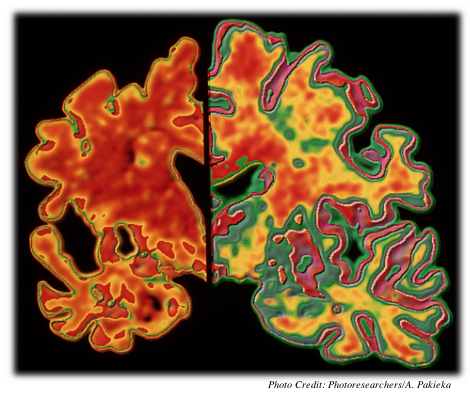Alzheimer’s Disease
Slide 1 of 14: Synopsis

Author
Elaine Cassel, Marymount University & Lord Fairfax Community College
Pamela Hill, San Antonio College
Tanya Renner, Kapiolani Community College
Cathie Robertson, Grossmont College
Synopsis
Alzheimer’s disease is the most common type of dementia. The diagnosis is generally based on symptoms and on the results of cognitive and medical tests. You will watch videos of people with Alzheimer’s and listen to experts and family members describe the progression of the disease and how it affects the caregivers as well.
References
Berger, K. S. (2011). The developing person through the life span, 8th ed. New York: Worth.
http://www.alz.org
National Institutes of Health. (2011, June). Alzheimer’s Disease Genetics: Fact Sheet (NIH Publication No. 11-6424). Retrieved from http://www.nia.nih.gov/alzheimers/publication/alzheimers-disease-genetics-fact-sheet
Slide 2 of 14: Introduction to Alzheimer’s Disease
- Chapters
- descriptions off, selected
- captions settings, opens captions settings dialog
- captions off, selected
This is a modal window.
Beginning of dialog window. Escape will cancel and close the window.
End of dialog window.
This is a modal window. This modal can be closed by pressing the Escape key or activating the close button.
This is a modal window.
Alzheimer’s disease is the most feared and most common type of dementia. Alzheimer’s accounts for 50 to 80 percent of dementia cases. Alzheimer’s disease is a progressive brain disorder that damages and destroys brain cells leading to a loss of memory, cognitive abilities, aspects of personality, and other brain functions and eventually leading to death. Current research has found effective treatments to slow down some of the memory loss and mood symptoms. In some cases, these treatments may work to a degree to prolong the physical life and preserve the quality of life for those who suffer from Alzheimer’s disease. In spite of this medical accomplishment, a cure has not yet been discovered.
Play the video to observe Alzheimer’s patients during a music therapy session at a nursing home.
Slide 3 of 14: Alzheimer’s Disease and the Brain
- Chapters
- descriptions off, selected
- captions settings, opens captions settings dialog
- captions off, selected
This is a modal window.
Beginning of dialog window. Escape will cancel and close the window.
End of dialog window.
This is a modal window. This modal can be closed by pressing the Escape key or activating the close button.
This is a modal window.
Sometimes called senile dementia of the Alzheimer type (SDAT), Alzheimer’s disease is characterized by brain abnormalities: (1) beta-amyloid plaques, (2) tangles of tau, (3) loss of connecting neurons among brain cells, and (4) brain inflammation. The interaction of these anomalies destroys the ability of neurons to effectively communicate with one another and eventually halts cortex function. While a multitude of these brain irregularities does confirm Alzheimer’s, individuals may exhibit some of these abnormalities and may not demonstrate any symptoms of Alzheimer’s.
Watch the video of Dr. Ken Davis, director of an Alzheimer’s research center at Mount Sinai School of Medicine, describing how these abnormalities in the brain lead to the loss of memory and personality. The video continues with an interview of family members who also describe the gradual cognitive and behavioral deterioration of their loved one.
Slide 4 of 14: Who Gets Alzheimer’s Disease?

Alzheimer’s disease is linked to genetics. The disease is rare in persons younger than age 60, but when it does occur in someone that young, it is known as early-onset Alzheimer’s disease. Early-onset Alzheimer’s is related to a mutation on one of three genes. Late-onset Alzheimer’s does not share this exact genetic association and is much more common. Researchers theorize that when Alzheimer’s disease appears in a person 60 or older, it is likely polygenic, which means that an allele on several genes contributes to the over-production of beta-amyloid protein that creates plaques around neurons. The fact that more than one gene is believed to be involved in late-onset Alzheimer’s makes it very challenging to isolate which genetic components might be involved. Even though the entire genetic profile of Alzheimer’s is not known, researchers are aware of at least one genetic risk-factor. While having one or more of the APOE ε4 allele does not guarantee that a person will develop the disease, it is considered a risk-factor gene as those who have one or more of this allele are more likely to develop Alzheimer’s.
Slide 5 of 14: How Alzheimer’s Progresses
- Chapters
- descriptions off, selected
- captions settings, opens captions settings dialog
- captions off, selected
This is a modal window.
Beginning of dialog window. Escape will cancel and close the window.
End of dialog window.
This is a modal window. This modal can be closed by pressing the Escape key or activating the close button.
This is a modal window.
Today, researchers believe that Alzheimer’s disease likely begins 10 - 20 years before they are able to definitively diagnose it probably because early symptoms may be easily explained away as normal aspects of aging. A person diagnosed with Alzheimer’s disease usually experiences gradual brain deterioration over a period of 10 to 15 years. This brain degeneration progresses through five identifiable stages that begin with symptoms as harmless-seeming as forgetfulness and end in death. Play this video to hear Dr. Ken Davis discuss the five stages of Alzheimer’s.
Match each description with one of the five stages of Alzheimer’s that Dr. Davis describes in this video clip.
Slide 6 of 14: How Alzheimer's Progresses (continued)
- Chapters
- descriptions off, selected
- captions settings, opens captions settings dialog
- captions off, selected
This is a modal window.
Beginning of dialog window. Escape will cancel and close the window.
End of dialog window.
This is a modal window. This modal can be closed by pressing the Escape key or activating the close button.
This is a modal window.
Slide 7 of 14: Prevention and Treatment for Alzheimer’s
- Chapters
- descriptions off, selected
- captions settings, opens captions settings dialog
- captions off, selected
This is a modal window.
Beginning of dialog window. Escape will cancel and close the window.
End of dialog window.
This is a modal window. This modal can be closed by pressing the Escape key or activating the close button.
This is a modal window.
A cure for Alzheimer’s disease has not yet been discovered, and even halting the progression of the disease is difficult. An early preventive step is to improve overall health by reducing the risk and impact of high blood pressure, diabetes, arteriosclerosis, and emphysema, all of which disrupt the flow of oxygen to the brain and are likely to aggravate the symptoms of dementia. Two major environmental risk factors associated with Alzheimer’s disease are lack of exercise and stress. Maintaining an exercise regimen throughout life is important as it helps to reduce stress and to sustain and perhaps enhance brain capacity which will increase resistance to some cellular changes in the brain.
All experts agree that early treatment for Alzheimer’s can make a difference. In the future, the ability to diagnose Alzheimer’s earlier will help scientists to test new medications that may stop or slow the over-production of beta-amyloid and tau. In the meantime, several new medications, such as cholinesterase inhibitors (Donepezil and Memantine), help to relieve some of the problems with mood and memory. These drugs enable Alzheimer’s patients to have several more years of close-to-normal functioning.
Neurologist Richard Mayeux of Columbia University discusses treatment for Alzheimer’s disease in this video.
Slide 8 of 14: Prevention and Treatment for Alzheimer’s (continued)
- Chapters
- descriptions off, selected
- captions settings, opens captions settings dialog
- captions off, selected
This is a modal window.
Beginning of dialog window. Escape will cancel and close the window.
End of dialog window.
This is a modal window. This modal can be closed by pressing the Escape key or activating the close button.
This is a modal window.
Watch this video of Roy, a 54-year-old man who suffers from early-onset Alzheimer’s disease.
Slide 9 of 14: Meet Two Caregivers
- Chapters
- descriptions off, selected
- captions settings, opens captions settings dialog
- captions off, selected
This is a modal window.
Beginning of dialog window. Escape will cancel and close the window.
End of dialog window.
This is a modal window. This modal can be closed by pressing the Escape key or activating the close button.
This is a modal window.
In 2012, approximately 15.4 million American family members and friends provided unpaid care for someone with Alzheimer’s disease or some type of dementia. In addition to taking a financial toll on caregivers, caring for a person with Alzheimer’s also leads to great physical and emotional stress as caregivers try to cope with the mental and physical deterioration of their loved one.
Watch this video to hear the experiences of two caregivers: the husband of an older female Alzheimer’s patient and the wife of 54-year-old Roy, the male Alzheimer’s patient who appears in a previous video clip. In this clip, you will also learn about research on the effects of stress on caregivers.
Slide 10 of 14: Life in a Nursing Facility
- Chapters
- descriptions off, selected
- captions settings, opens captions settings dialog
- captions off, selected
This is a modal window.
Beginning of dialog window. Escape will cancel and close the window.
End of dialog window.
This is a modal window. This modal can be closed by pressing the Escape key or activating the close button.
This is a modal window.
Eventually, the disease progresses to the point when the Alzheimer’s patient requires full-time nursing care.
Watch this video excerpt from the movie entitled Alzheimer’s Disease: A Family Affair, in which Rochelle lives in a nursing facility for Alzheimer’s patients and is being visited by her granddaughter.
Slide 11 of 14: Assessment: Check Your Understanding

Slide 12 of 14: Assessment: Check Your Understanding

Slide 13 of 14: Assessment: Check Your Understanding

Slide 14 of 14: Assessment: Check Your Understanding

Congratulations! You have completed this activity.Total Score: x out of x points (x%) You have received a provisional score for your essay answers, which have been submitted to your instructor.